
Environmental reporter Julie Ryan says neighborhood nature walks keep her grounded in trying times. Photos by Julie Ryan.
May 13, 2020
Do you have a green place that restores you? I go to my neighborhood creek trail, White Rock Trail in north Dallas, as often as I can. Walking in the fresh air, with the murmur of flowing water and trees stirring in the breeze, brings me back to myself.
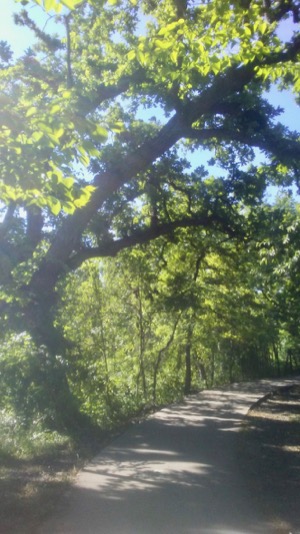 White Rock Creek Trail in North Dallas.
White Rock Creek Trail in North Dallas.
During the lockdown, the trail as been a getaway for some much-needed head space. Away from worries about the double whammy of worldwide coronavirus and climate change.
Even social-distancing and wearing a cloth face mask, it’s a relief. Strangers greet each other from six feet apart as happily as friends. When I see my trail buddy, Richard, and ask “How are you?" he always answers, "Just another day in paradise!"
White Rock Creek flows from up north of the George Bush Tollroad, south to White Rock Lake, hidden between people's backyards for much of its route. But for .75-miles between Celestial Park and Winnwood Park, affluent homeowners and the city collaborated to leave a greensward open along the creek.
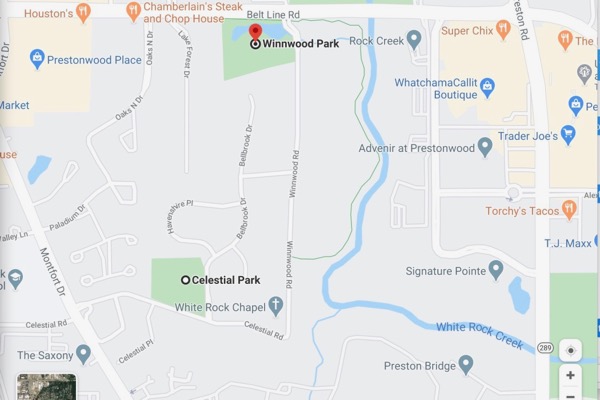 White Rock Creek Trail runs between Celestial Park and Winnwood Park.
White Rock Creek Trail runs between Celestial Park and Winnwood Park.
A resident-owned swathe behind the homes, unfenced, flanks the trail on one side. On the creek side there's a ribbon of wild shrubs and vines sheltering below enormous trees. The wild remains from rural times before 1950s development. A tree or two are circled by barbed wire embedded in their trunks, and an old well still stands, capped.
The greenbelt falls away 50 feet or more to the creek bed, where the water sometimes flows green and inches deep, sometimes brown, foamy and roaring, 30 feet at flood stage. Its channel's walled by deep blackland soil in stretches.
In one expanse, though, the creek wall is a cliff of layered white-and-gray limestone and shale, rock formed over millennia from the shells of prehistoric sea life back when north and central Texas were intermittently undersea.
Huge burr oaks with woolly-capped acorns big as hen eggs and hand-sized leaves cast shade among pecans and cedar elms.
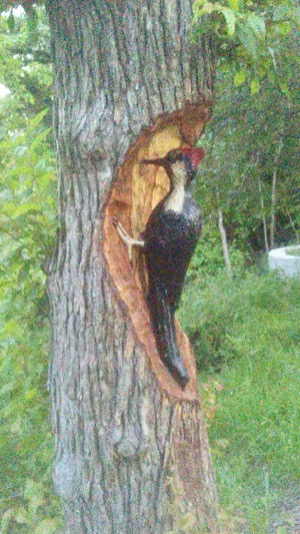 A woodpecker is among the animals carved into tree stumps along the trail.
A woodpecker is among the animals carved into tree stumps along the trail.
Last year, a tree carver sculpted stumps along the trail into larger-than-life renderings of wildlife, some found there: woodpecker, owl and beaver.
Meanwhile, undergrowth shelters real birds, squirrels, rabbits and occasionally a bobcat. There's also white-tailed dove, tiny tufted titmice and scores of other birds, monarch and swallowtail butterflies, turtles galore.
WILDFLOWER POWER
Walking along I admire, on the civilized side, the cathedral-like arcs of 100-year-old trees, spanning the mowed, green commons. Maintenance is owner's choice. Some prefer to let theirs alone to grow wild grasses and flowers like violets, a yellow Queen Anne's lace look-alike, blue-eyed grass, Mexican petunia, Carolina bluets.
The wild patches sparkle with fireflies on summer nights. The scalped ones lose topsoil into the creek in heavy rains.
Wildflowers are what brought me to the green movement in the first place.
The first Earth Day in 1970 was eclipsed for me by the Vietnam War. There were teach-ins for the peace movement on the University of Texas campus in Austin. Earth Day had its venues, too, but they were overshadowed.
But during a three-year sojourn in southern California after college, I joined actions against nuclear power. We couldn't see how nuclear waste toxic to life for longer than the lifespan of its containment vessels could be a good thing.
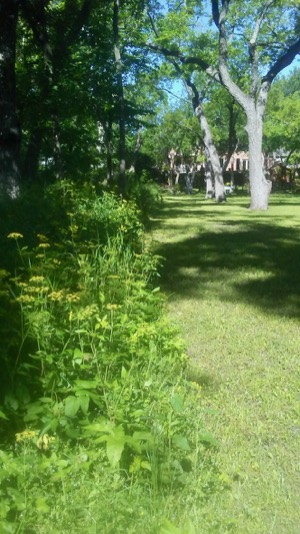 Manicured backyards border wild spaces.
Manicured backyards border wild spaces.
Back in Texas, I was enchanted by the highways and byways we had traveled on family trips, swathed with wildflowers. These had only thrived as First Lady Lady Bird Johnson worked to protect native plants, beautify the nation and, at home, influenced the Texas highway department to protect Texas wildflowers. She persuaded them to schedule roadside mowings after wildflower seeds matured, to fall and replenish.
The natural outdoors had always been part of our family's lives, living in four towns around the state and traveling to West Texas to visit relatives and vacationing on the Gulf and Lake Austin. Back home again, I visited what is now Cedar Ridge Preserve in southwest Dallas County, and learned about the tall-grass prairies from walks on a remnant prairie at Straus Farm with Dr. Geoffrey Stanford, the center's founder.
What you love, you want to see thrive. I went on to write about prairies and native plants, co-author one of Texas' first native plant books and articles for Texas Highways and many other publications.
PROTECTING WILD PLACES
What you love, welcome wherever you find it. This makes a trail walk even more enjoyable.
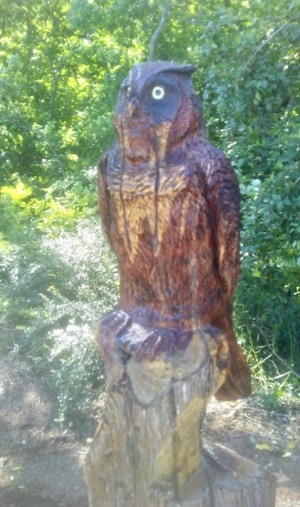 Owl carving seen along the trail.
Owl carving seen along the trail.
However, I recognize things are changing: the snowfalls of childhood dwindling, rain patterns altering violently, drought extending. Farmers and ranchers struggling or bankrupted. Over the years, honoring Earth Day and its legal heritage - the Clean Air Act, the Clean Water Act, Endangered Species Act, the Superfund program - became important to me. Even more so, as climate disruption's patterns have become clearer.
Above White Rock North, the cliff tops themselves lose soil in our increasingly heavy downpours, and the banks are hollowed out. In seven years living here, I've seen six feet of cliff top eroded away in some spots. Giant trees above the creek grip the soil as many seasons as they can, and then topple in a flood.
Seeing what we know, love and depend on changing, makes it real to us.
There are solutions. I go to EarthX conferences every year, support Sierra Club, keep up with 350.org, Citizens Climate Lobby and city government to find out how we can progress to overcome climate change and myriad other challenges to the wellbeing of ourselves and everything living.
In 2014, my writing refocused from native plants and landscapes to environmental disruption, solutions and actions everyone can take.
TRAIL OF DREAMS
I'm grateful I can still walk the trail, hearing the barred owls call "Who-cooks-for-you? Who-cooks-for-you?" and the cardinals sing "Sweet-sweet-sweet-pretty-pretty-pretty!"
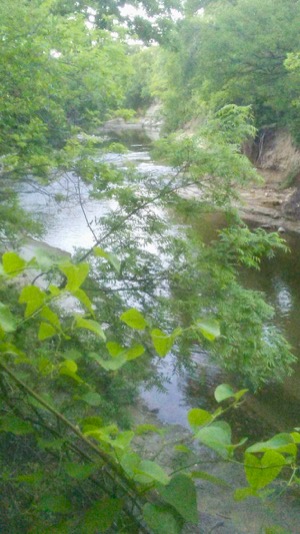 A glimpse of White Rock Creek.
A glimpse of White Rock Creek.
As evening came on during my trail walk, I looked down into the creek and was startled to see a coyote striding down the middle of the stream. I grabbed for my camera, but he had disappeared like smoke. Moments later, a dad and three children came toward me, looking back over their shoulders.
"What are you looking for?" I asked.
"We don't know," they said. "A dog?"
We heard a howl in the distance, and we two adults laughed. I've seen small bobcats along the trail, but not a coyote before. The creek and the corridor of wild that surrounds it is their home.
 Selfie with facemask.
Selfie with facemask.
When I got back to the trailhead, darkness had fallen.
In the dark western sky, Venus shone. Instead of only the star or two I'd been able to see before the coronavirus shutdown, half of the Winter Circle sparkled: seven stars, including "the twins" Castor and Pollux, an arc through the sky from south to west.
Clear, clean air. Maybe we can keep it after the shutdown - with a new, thriving low-carbon economy.
That would be Earth Day, every day! Another day in paradise.
Stay up to date on everything green in North Texas, including the latest news and events! Sign up for the weekly Green Source DFW Newsletter! Follow us on Facebook and Twitter. Also check out our new podcast The Texas Green Report, available on your favorite podcast app.









